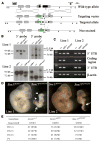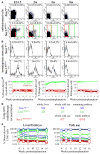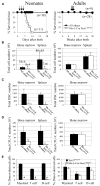Sox17 dependence distinguishes the transcriptional regulation of fetal from adult hematopoietic stem cells
- PMID: 17655922
- PMCID: PMC2577201
- DOI: 10.1016/j.cell.2007.06.011
Sox17 dependence distinguishes the transcriptional regulation of fetal from adult hematopoietic stem cells
Abstract
Fetal stem cells differ phenotypically and functionally from adult stem cells in diverse tissues. However, little is known about how these differences are regulated. To address this we compared the gene expression profiles of fetal versus adult hematopoietic stem cells (HSCs) and discovered that the Sox17 transcriptional regulator is specifically expressed in fetal and neonatal but not adult HSCs. Germline deletion of Sox17 led to severe fetal hematopoietic defects, including a lack of detectable definitive HSCs. Conditional deletion of Sox17 from hematopoietic cells led to the loss of fetal and neonatal but not adult HSCs. HSCs stopped expressing Sox17 approximately 4 weeks after birth. During this transition, loss of Sox17 expression correlated with slower proliferation and the acquisition of an adult phenotype by individual HSCs. Sox17 is thus required for the maintenance of fetal and neonatal HSCs and distinguishes their transcriptional regulation from adult HSCs.
Figures







Comment in
-
Fetal to adult stem cell transition: knocking Sox17 off.Cell. 2007 Aug 10;130(3):403-4. doi: 10.1016/j.cell.2007.07.027. Cell. 2007. PMID: 17693249 Review.
Similar articles
-
Fetal to adult stem cell transition: knocking Sox17 off.Cell. 2007 Aug 10;130(3):403-4. doi: 10.1016/j.cell.2007.07.027. Cell. 2007. PMID: 17693249 Review.
-
Sox17 expression confers self-renewal potential and fetal stem cell characteristics upon adult hematopoietic progenitors.Genes Dev. 2011 Aug 1;25(15):1613-27. doi: 10.1101/gad.2052911. Genes Dev. 2011. PMID: 21828271 Free PMC article.
-
Sox17-mediated maintenance of fetal intra-aortic hematopoietic cell clusters.Mol Cell Biol. 2014 Jun;34(11):1976-90. doi: 10.1128/MCB.01485-13. Epub 2014 Mar 24. Mol Cell Biol. 2014. PMID: 24662049 Free PMC article.
-
Dual lineage-specific expression of Sox17 during mouse embryogenesis.Stem Cells. 2012 Oct;30(10):2297-308. doi: 10.1002/stem.1192. Stem Cells. 2012. PMID: 22865702 Free PMC article.
-
Sox17 and Other SoxF-Family Proteins Play Key Roles in the Hematopoiesis of Mouse Embryos.Cells. 2024 Nov 7;13(22):1840. doi: 10.3390/cells13221840. Cells. 2024. PMID: 39594589 Free PMC article. Review.
Cited by
-
Less is more: unveiling the functional core of hematopoietic stem cells through knockout mice.Cell Stem Cell. 2012 Sep 7;11(3):302-17. doi: 10.1016/j.stem.2012.08.006. Cell Stem Cell. 2012. PMID: 22958929 Free PMC article. Review.
-
Epigenetic Regulation in Oral Squamous Cell Carcinoma Microenvironment: A Comprehensive Review.Cancers (Basel). 2023 Nov 27;15(23):5600. doi: 10.3390/cancers15235600. Cancers (Basel). 2023. PMID: 38067304 Free PMC article. Review.
-
Defining the Emerging Blood System During Development at Single-Cell Resolution.Front Cell Dev Biol. 2021 May 12;9:660350. doi: 10.3389/fcell.2021.660350. eCollection 2021. Front Cell Dev Biol. 2021. PMID: 34055791 Free PMC article. Review.
-
Intercellular interactions, position, and polarity in establishing blastocyst cell lineages and embryonic axes.Cold Spring Harb Perspect Biol. 2012 Nov 1;4(11):a008235. doi: 10.1101/cshperspect.a008235. Cold Spring Harb Perspect Biol. 2012. PMID: 23125013 Free PMC article. Review.
-
Sean Morrison: A root and branch approach to stem cells.J Cell Biol. 2010 Jun 28;189(7):1056-7. doi: 10.1083/jcb.1897pi. J Cell Biol. 2010. PMID: 20584911 Free PMC article.
References
-
- Azcoitia V, Aracil M, Martinez AC, Torres M. The homeodomain protein Meis1 is essential for definitive hematopoiesis and vascular patterning in the mouse embryo. Dev Biol. 2005;280:307–320. - PubMed
-
- Chambers I, Colby D, Robertson M, Nichols J, Lee S, Tweedie S, Smith A. Functional expression cloning of Nanog, a pluripotency sustaining factor in embryonic stem cells. Cell. 2003;113:643–655. - PubMed
-
- Davidson AJ, Ernst P, Wang Y, Dekens MP, Kingsley PD, Palis J, Korsmeyer SJ, Daley GQ, Zon LI. cdx4 mutants fail to specify blood progenitors and can be rescued by multiple hox genes. Nature. 2003;425:300–306. - PubMed
Publication types
MeSH terms
Substances
Grants and funding
LinkOut - more resources
Full Text Sources
Other Literature Sources
Molecular Biology Databases
Research Materials

